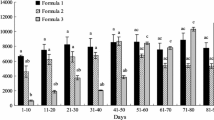Abstract
IN an earlier investigation1, I established that the pupal diapause of the butterfly Phalera bucephala L. is characterized by a very low respiratory quotient, RQ 0.1–0.3. During consecutive developmental stages, after incubation by cold, the respiratory quotient rises to correspondingly higher steady levels up to c. 0.8 at emergence. During diapause it is too low to be explained by complete combustion of ordinary reserve nutriment of the pupa and must represent a transformation of an oxygen-rich compound into an oxygen-poor compound. A conversion of fatty acids into carbohydrate is assumed, possibly by way of acetate-succinate2. The low respiratory quotient has nothing to do with a rhythmic expulsion of carbon dioxide3. In the pupæ examined, no fluctuations in the respiratory quotient have been found during prolonged series of measurements, and, furthermore, the carbon dioxide production decreases with increasing temperature. Therefore the low respiratory quotient must be due to a disturbed carbon dioxide production, probably a blocking of the decarboxylating part of the tricarboxylic acid cycle. According to ecological literature, pupal diapause of different insects can be induced by environmental factors prevailing during the larval stage. All these factors mean a direct or indirect restriction of the intake of nourishment: starvation, lowered temperature, kind of food4, duration of daylight5, and others. It is therefore not unlikely that this hibernation diapause may be explained by a vitamin deficiency, by a temporary inability to resynthesize some important compounds. Two vitamins form integral parts of enzymes active in the decarboxylating part of the tricarboxylic acid cycle, namely, aneurin in cocarboxylase and pantothenic acid in coenzyme A.
Similar content being viewed by others
References
Agrell, L., Ark. Zool., 39 A, No. 10 (1947).
Ochoa, S., Veiga Salles, J. B., and Ortiz, P. J., J. Biol. Chem., 187, 872 (1950).
Punt, A., Physiol. Comp. et Oecol., 2, 59 (1950).
Steinberg, O. M., and Kamensky, S. A., Butt. Biol. Fr. Belg., 70, 145 (1936).
Way, M. J., Hopkins, B., and Smith, P. M., Nature, 164, 615 (1949).
Williams, C. M., Growth Symp., 12, 61 (1948).
Agrell, I., Acta Physiol. Scand., 18, 355 (1949).
Author information
Authors and Affiliations
Rights and permissions
About this article
Cite this article
AGRELL, I. Pupal Diapause caused by Vitamin Deficiency. Nature 167, 283–284 (1951). https://doi.org/10.1038/167283a0
Issue Date:
DOI: https://doi.org/10.1038/167283a0
- Springer Nature Limited





